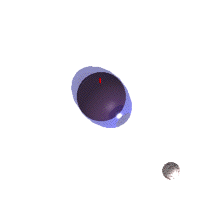
| Home |
| Glossary |
| Lobstering |
| Some Facts |
| Handling Gear |
| Wildlife |
| Tools |
| A Day at Sea |
| The Boat |
| Lobsters |
| Facts |
| Molting |
| Eggers |
| Oversized |
| The Sea |
| About Tides |
| Misc |
| Credits |
| Site Policy |
| The Author |
| Today's Hi/Lo Tides |
12/09/25
02:10 8.843 H
08:00 0.407 L
14:20 9.9 H
20:45 -0.473 L
Station: Fort Point, NH
Station-local tide times. Height in Feet (MLLW).
Data are predictions supplied by the NOAA Tidal Predictions
Web Service.
Last updated:
12/09/25 05:59 UTC |
Tides
Tides refer to the vertical motion of water caused by the gravitational effects of the sun and moon. Currents refer to the horizontal movement of water. Tidal currents, then, refer to the horizontal movement of water caused by the vertical movement of tides.
Tides and the resulting tidal currents are to a sailor as winds are to an airplane pilot. Without a thorough understanding of them, navigation becomes inefficient, or even dangerous, and the simplest landing can end in tragedy.
Every boat must eventually come to shore, where the tides and their currrents most influence navigation. Entering in-shore waters without knowledge of the local effects of tidal currents can be a recipe for disaster. For example, a cruise ship was recently driven into a bridge over Portsmouth Harbor (NH) by tidal currents because the captain did not appreciate how swift the ebb tidal currents can get in that harbor.
Why tides occur and their periodicity is the result of a complex set of interactions of gravitational and centrifugal forces exerted by several bodies at once. Moreover, tides at any given place are also effected by factors such as land masses, coastal features, weather, oceanic currents, sea bottom topography, and many more that exceed the scope of this page. Clearly this is a complicated topic. Much of what follows is a simplification of the actual phenomena, but I hope it is sufficient to illustrate the origin and behavior of tidal motion.
Note: All illustrations on this topic are not intended to be accurate in scale or movement. They are only meant to help visualize the forces at work. For example, in the image below there is a solar and lunar eclipse during every revolution. This, of course, does not happen in nature. Relative sizes and distances are also greatly exaggerated for clarity.

The moon does not orbit the earth. The two actually orbit each other around a point about 1,100 miles inside the earth.
Forces that generate tides - Some background on the dynamics of the earth-moon-sun system and how basic tides are formed.
The motion - The earth, moon, and sun all act together. Here are some animations to illustrate this.
Types of Tides - Taken together, all these different forces create different types of tides.
Tidal currents - Where land meets sea, tidal currents are a major consideration in safe navigation.
Tide Tables - What they look like and how to read them.